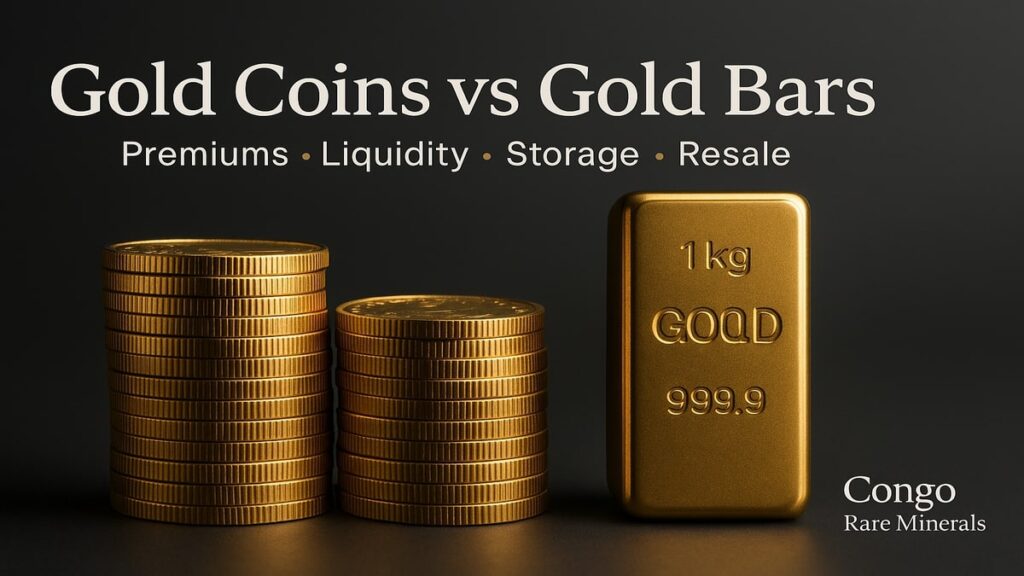If you’re buying physical gold for the first time, this is the question that matters. Coins and bars both protect wealth. They don’t behave the same when it comes to premium, liquidity, storage, and resale. Here’s a clear way to choose what fits your budget and exit plan.
Quick answer
- Under $10,000: small coins or 100 g bars for flexibility and easy resale.
- $10,000–$75,000: mix 1 oz coins with 100–250 g bars to balance liquidity and premium.
- $75,000+ or institutional: 1 kg bars for the lowest premium per gram, with a plan for verification at resale.
Snapshot: coins vs bars
| Factor | Gold Coins | Gold Bars |
|---|---|---|
| Typical premium over spot | Higher | Lower (drops as size increases) |
| Liquidity (retail) | Very high | High for 100 g–250 g; lower for 1 kg retail |
| Recognition | Global mint brands | Strong; brand matters less than assay |
| Storage efficiency | Less efficient | Most efficient per dollar stored |
| Resale friction | Low; easy to quote | May require assay for top price |
| Best for | Small–mid budgets, gifting, fast resale | Larger tickets, long-term holds |
What you’re paying: premium and total cost
Spot price is the raw metal value. Premium is what you pay above spot to cover minting, branding, distribution, and handling.
- Coins: often carry higher premiums because of minting detail and brand demand. One-ounce Eagles, Maples, or Britannias can trade at meaningful premiums even in calm markets.
- Bars: premiums fall as bars get larger. A 1 kg bar usually has the lowest cost per gram. Small bars (1–10 g) can have coin-like premiums.
Rule of thumb: if you plan to hold for years and buy in size, bars give you more metal for your money.
Liquidity and resale
Both forms are liquid if you stick to standard sizes and keep documents.
- Coins: easy to price and sell to dealers and private buyers. Recognition is instant. Great for partial liquidation.
- Bars: 100–250 g bars are liquid with reputable paperwork. 1 kg bars are perfect for large trades but can need assay confirmation at resale to reach best price. We arrange third-party verification when needed via our Lab Testing and Refining partners.
Storage and logistics
- Coins: take more space per dollar of value. Use tubes or capsules. Good for gradual stacking.
- Bars: pack dense value in less space. Lower insurance and shipping cost per dollar of value. Ideal for vaulting or international transport.
Taxes and documents
Your final cost may include shipping, insurance, certificates, export permits, and destination taxes. We state these on your pro-forma invoice and include the standard document pack with every export. See Contact for country-specific guidance.
Who should favor coins
- You want maximum flexibility and the option to sell a few ounces at a time.
- You prefer globally recognized one-ounce units.
- You are building a position in small monthly budgets.
Who should favor bars
- You’re buying $25,000+ and want lowest premium per gram.
- You plan to vault or transport internationally.
- You are comfortable reselling through a dealer or refinery with an assay.
Example portfolios
Starter, ~$5,000
- 2–3 oz in coins plus remainder in a 100 g bar. Flexible and simple.
Builder, ~$25,000
- 250 g bar + 5–7 oz in coins. Efficient storage with some small, liquid units.
Allocator, ~$75,000–$150,000
- 1 kg bar + 5–10 oz in coins. Lowest premium with optional partial resale.
Common mistakes to avoid
- Chasing the lowest sticker price and ignoring premium and resale.
- Buying odd sizes that few dealers stock. Stick to 1 oz coins, 100 g, 250 g, 1 kg bars.
- Skipping documentation. Keep your invoice, assay, certificate of origin, and shipping papers together for future resale.
How Congo Rare Minerals helps you choose
- 22K and 24K options with minimum order of 100 g.
- KYC/AML completed before any price lock for a clean transaction.
- Insured export to approved destinations with a clear documents pack.
- Verification support at a buyer-nominated refinery when required.
Ready to act
- Browse live products: Shop
- Confirm availability and get a pro-forma: Contact Sales
- Learn how testing works: Lab Testing

